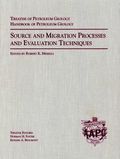Petroleum source rock formation
| Source and Migration Processes and Evaluation Techniques | |

| |
| Series | Treatise Handbook |
|---|---|
| Part | Petroleum Generation and Migration |
| Chapter | Petroleum Source Rocks and Organic Facies |
| Author | S. R. Jacobson |
| Link | Web page |
| PDF file (requires access) | |
| Store | AAPG Store |
Petroleum source rock formation requires both (1) sufficient biological productivity to create large quantities of organic matter and (2) suitable depositional conditions for its concentration and preservation. Creation of most hydrogen-rich, oil prone, sedimentary organic matter is ultimately attributed to photosynthesis and nutrient supply. Under appropriate conditions, phytoplankton and/or algal/bacterial mats form in lacustrine, estuarine, and marine paleoenvironments, and land plants that comprise coals form in terrestrial environments. Nutrient replenishment, sunlight, temperature, pH and Eh of waters, sediments, and soils influence biological productivity.
Source rocks form where depositional conditions shelter organic matter from destruction by oxidation and from extreme dilution by mineral input. Organic matter is preserved in oxygen-restricted sediments at depths below wave base, in stagnant waters where density or temperature-stratified water columns form, and in other areas where oxygen replenishment is low.[1] The exposure time of hydrogen-rich organic matter to chemically destructive agents is crucial. Therefore, water column conditions may be as important as those in the upper few centimeters of sediment. Organic-rich sediments often retain millimeter-thick depositional laminae, which reflect no sediment-churning bioturbation. Bioturbation records sediment invasion mainly by animals grazing on hydrogen-ri h sedimentary organic matter.
See also
References
- ↑ Demaison, G. J., and G. T. Moore, 1980, Anoxic environments and oil source bed genesis: American Association of Petroleum Geologists Bulletin, v. 64, p. 1179-1209.